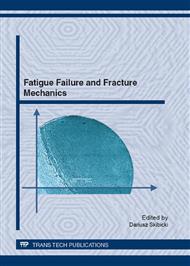[1]
Zioupos P., Casinos A.: Cumulative damage and the response of human bone in two-step loading fatigue, Journal of Biomechanics 1998, 31(9): 825-833
DOI: 10.1016/s0021-9290(98)00102-x
Google Scholar
[2]
Kosmopoulos V., Keller T.S: Predicting trabecular bone microdamage initiation and accumulation using a non-linear perfect damage model. Medical Engineering and Physics 2008, 30: 725-732
DOI: 10.1016/j.medengphy.2007.02.011
Google Scholar
[3]
Rapillard L., Charlebois M., Zysset P.K.: Compressive fatigue behavior of human vertebral trabecular bone, Journal of Biomechanics 2006, 39(11): 2133-2139
DOI: 10.1016/j.jbiomech.2005.04.033
Google Scholar
[4]
Tang S.Y., Vashishth D.: A non-invasive in vitro technique for the three-dimensional quantification of microdamage in trabecular bone. Bone 2007, 40: 1259-1264
DOI: 10.1016/j.bone.2006.10.031
Google Scholar
[5]
Cotton J.R., Winwood K., Zioupos P., Taylor M.: Damage rate is a predictor of fatigue life and creep strain rate in tensile fatigue of human cortical bone samples. Journal of Biomechanical Engineering 2005, 127: 213-219
DOI: 10.1115/1.1865188
Google Scholar
[6]
Haddock S.M., Yeh O.C., Mummaneni P.V., Rosenberg W.S., Keaveny T.M.: Similarity in the fatigue behavior of trabecular bone across site and species. Journal of Biomechanics 2004, 37(2): 181-187
DOI: 10.1016/s0021-9290(03)00245-8
Google Scholar
[7]
Michel M.C., Guo X.E., Gibson L.J., McMahon T.A., Hayes W.C.: Compressive fatigue behavior of bovine trabecular bone. J Biomechanics 1993, 26(4/5): 453-463
DOI: 10.1016/0021-9290(93)90009-4
Google Scholar
[8]
Pattin C. A., Caler W. E., Carter D. R.: Cyclic mechanical property degradation during fatigue loading of cortical bone, Journal of Biomechanics 1996, 29(1): 69-79
DOI: 10.1016/0021-9290(94)00156-1
Google Scholar
[9]
Ganguly P., Moore T.L. A., Gibson L.J.: Analysis of fatigue damage in bovine trabecular bone. www.asbweb.org
Google Scholar
[10]
Moore T.L., Gibson L.J.: Fatigue of Bovine Trabecular Bone. Journal of Biomechanical Engineering 2003, 125: 761-768
DOI: 10.1115/1.1631583
Google Scholar
[11]
Landgraf R.W., Morrow J., Endo T.: Determination of the cyclic stress-strain curve. J of Materials 1969, 4: 1621-1653
Google Scholar
[12]
Janzen W., Ehrenstein G.W.: Bemessungsgrenzen von glasfaserverstärktem PBT bei schwingender Beanspruchung. Kunststoffe 1991, 81(3): 231-236
Google Scholar
[13]
Orth F., Hoffmann L., Zilch-Bremer H., Ehrenstein G.W.: Evaluation of composites under dynamic load. Composite Structure 1993, 24(3): 265-272
DOI: 10.1016/0263-8223(93)90220-k
Google Scholar
[14]
El Fray M.: A long-term mechanical fatigue examination of thermoplastic elastomers. Elastomery 2004, 8(5): 15-19
Google Scholar
[15]
Casado J.A., Carrascal I., Polanco J.A., Gutiérrez-Solana F.: Fatigue failure of short glass fibre reinforced PA 6.6 structural pieces for railway track fasteners. Engineering Failure Analysis 2006, 13(2): 182-197
DOI: 10.1016/j.engfailanal.2005.01.016
Google Scholar
[16]
Dendorfer S., Maier H.J., Taylor D., Hammer J.: Anisotropy of the fatigue behaviour of cancellous bone. J Biomech. 2008; 41(3): 636-41
DOI: 10.1016/j.jbiomech.2007.09.037
Google Scholar
[17]
Topoliński T., Cichański A., Mazurkiewicz A., Nowicki K., Study of the behavior of the trabecular bone under cyclic compression with stepwise increasing amplitude, Journal of the Mechanical Behavior of Biomedical Materials 2011, Vol. 4, No. 8: 1755-1763
DOI: 10.1016/j.jmbbm.2011.05.032
Google Scholar
[18]
Topoliński T., Cichański A., Mazurkiewicz A., Nowicki K., Applying a stepwise load for calculation of the S-N curve for trabecular bone based on the linear hypothesis for fatigue damage accumulation, Fatigue Failure and Fracture Mechanics 2012, In Press
DOI: 10.4028/www.scientific.net/msf.726.39
Google Scholar


